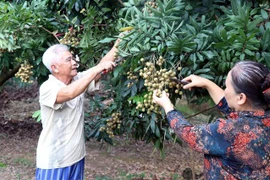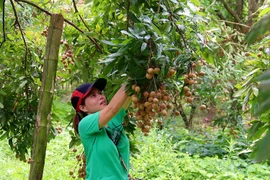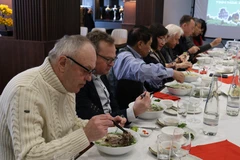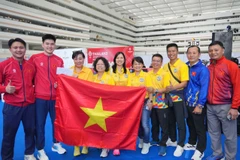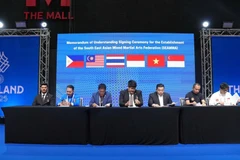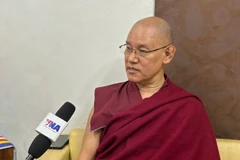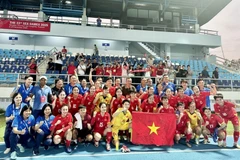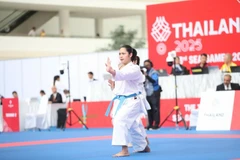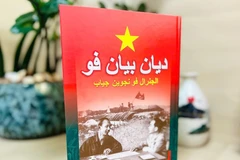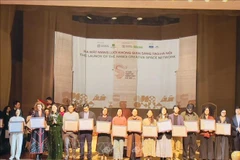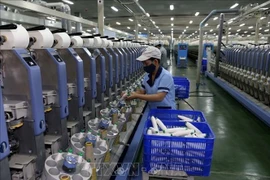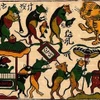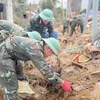 Chuong Pagoda is one of the typical relics in the ancient Pho Hien (Hien Street) relic complex. (Photo: VNA)
Chuong Pagoda is one of the typical relics in the ancient Pho Hien (Hien Street) relic complex. (Photo: VNA)
Hung Yen (VNA) - Located in the centre of the Red River Delta, the northern province of Hung Yen boasts various tangible and intangible cultural heritage items, which holds great potential for tourism development.
The locality currently is home to over 1,800 historical sites, including three special national sites and 175 national sites, as well as seven artefacts and groups of artefacts recognised as national treasures.
Notable sites are special national relic sites Pho Hien in Hung Yen city, Thai Lac Temple in Van Lam district, and An Xa Temple in Tien Lu district.
In recent years, the local authorities have paid attention to restoring relics to meet the cultural and religious demands of the people.
Hung Yen province also has a rich trove of intangible heritage with over 500 traditional festivals such as Pho Hien Folk Culture Festival in Hung Yen city, Chu Dong Tu – Tien Dung Festival in Khai Chau district, Dau An Temple Festival in Tien Lu district, and hundreds of traditional craft villages.
The locality is also famous for many specialties such as longan, Dong Tao chicken, and eel vermicelli.
In addition, Hung Yen is also known for its ancient rivers and villages, which have contributed to the unique charm of Pho Hien tourism.
The ancient Pho Hien (Hien Street) relic complex, which is located in Dang Chau village (Lam Son district) and Ne Chau village (Hong Chau district) in Hung Yen city, used to be a bustling commercial port on the Red River with its heyday in the 17th -18th century.
 Mau Temple is one of the historical relics in the ancient Pho Hien (Hien Street) relic complex. (Photo: VNA)
Mau Temple is one of the historical relics in the ancient Pho Hien (Hien Street) relic complex. (Photo: VNA)
Pho Hien was second to only the Imperial capital city of Thang Long as a trading point. It was well-known among foreign traders, especially those from China, Japan and the Netherlands.
The area is home to more than 100 cultural and historical relics, including Hien Pagoda, Mau (Goddess) Temple, May (Cloud) Temple and Chuong Pagoda. Eighteen of them have received national recognition.
Pho Hien is one of the three special national historical sites of Hung Yen province recognized in 2014.
To preserve and promote the value of its cultural sites, Hung Yen has made an annual investment in renovating such sites.
The locality has selected notable cultural intangible heritages for long-term preservation, such as the Da Hoa-Da Trach Festival, the Dau An Temple Festival, the Quan Xuyen Communal House Festival, among others.
According to Director of the provincial Department of Culture, Sports and Tourism Do Huu Nhan, to promote and harness the value of its heritage, the local authorities are enhancing communication campaigns to introduce the exemplary values of its cultural heritage system through leaflets, social media networks, video clips, and by participation in trade fairs and exhibitions.
Several sites have become popular destinations for tourists, such as Pho Hien, Da Hoa-Da Trach complex, An Xa Temple, Phu Ung Temple, Nom Village and Nom Temple.
The locality will continue to survey, collect and research local intangible heritage items, especially those facing the risk of loss, as well as formulate plans to preserve typical cultural values of the community, and constantly reproduce and pass on intangible cultural heritages from generation to generation oratorically, as well as the transfer of techniques and performing.
It is also working to digitise information on its intangible cultural heritages and select outstanding intangible cultural heritages to be considered for inclusion on the national list.
In addition, Hung Yen will work to further enhance the quality of tourism products with local characteristics by introducing tours to explore cultural and historical sites, traditional craft villages and scenery, and promoting festival tourism and ecotourism./.


